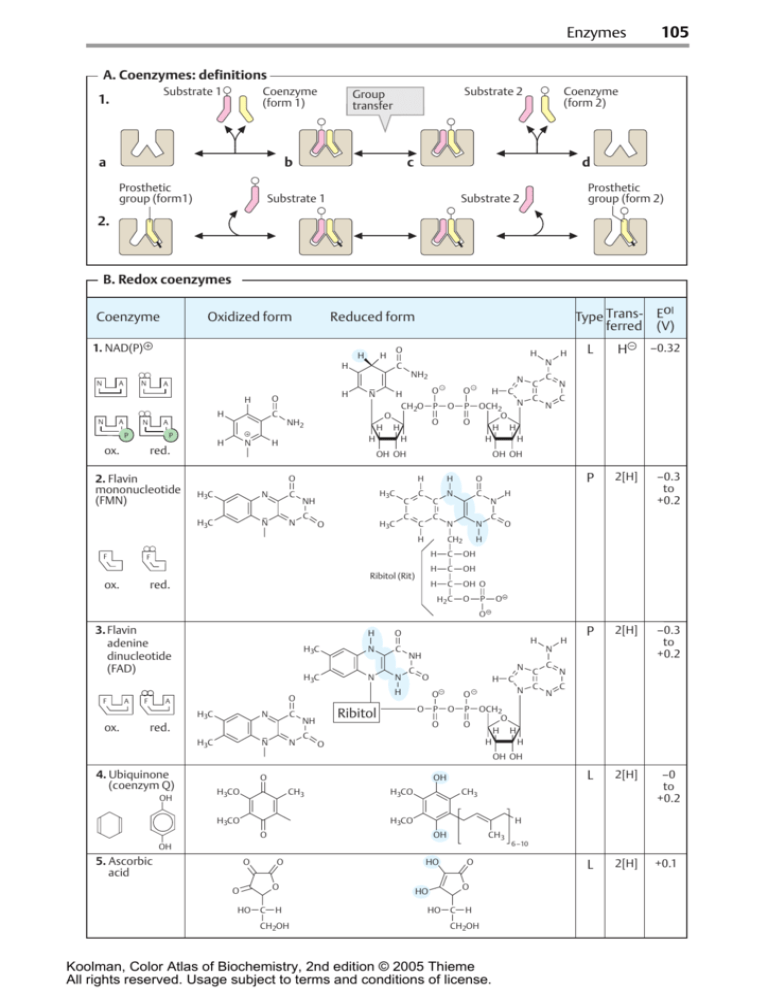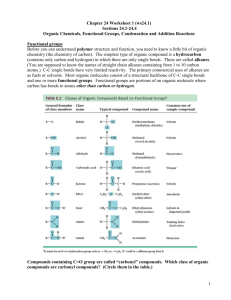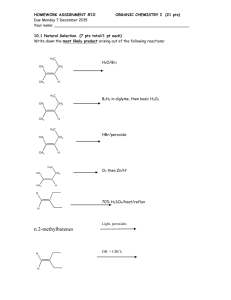
Enzymes
105
A. Coenzymes: definitions
Substrate 1
1.
Coenzyme
(form 1)
a
Substrate 2
Group
transfer
b
Prosthetic
group (form1)
Coenzyme
(form 2)
c
d
Substrate 1
Prosthetic
group (form 2)
Substrate 2
2.
B. Redox coenzymes
Oxidized form
Coenzyme
ol
Type Trans- E
ferred (V)
Reduced form
1. NAD(P)
H
O
H
H
H
C
NH2
N
A
N
A
O
H
H
A
N
ox.
N
H
red.
2. Flavin
mononucleotide
(FMN)
N
H
CH2O P
OH OH
OH OH
N
C
H3C
N
N
H
H 3C
NH
C
C
C
H 3C
O
C
C
C
C
H
F
F
ox.
Ribitol (Rit)
red.
O
P
O
H
O
H3C
C
H
H
H
H
H
O
N
OCH2
O
O
H H
H
H
O
NH2
P
N
O
C
A
N
P
H
H
–0.32
L
H
P
2[H]
–0.3
to
+0.2
P
2[H]
–0.3
to
+0.2
L
2[H]
–0
to
+0.2
L
2[H]
+0.1
N
H
O
N
C
N
N
CH2
H
H
C
OH
H
C
OH
H
C
OH O
H2 C
O
N
C
P
C
C
C
N
N
C
H
O
O
O
3. Flavin
adenine
dinucleotide
(FAD)
F
A
F
O
H3C
N
C
H3C
N
N
N
C
red.
H3C
N
N
H
C
N
O
H
O
O P
Ribitol
NH
H
N
NH
H
O
A
H3C
ox.
H
N
O
O
O
C
O
C
C
C
C
N
N
C
P
OCH2
O
O
H H
H
H
OH OH
4. Ubiquinone
(coenzym Q)
OH
O
OH
H3CO
CH3
H3CO
H3CO
CH3
H3CO
H
O
OH
CH3
OH
5. Ascorbic
acid
O
O
O
O
HO
C
H
CH2OH
HO
O
O
HO
HO
C
H
CH2OH
Koolman, Color Atlas of Biochemistry, 2nd edition © 2005 Thieme
All rights reserved. Usage subject to terms and conditions of license.
6–10
106
Metabolism
Coenzymes 2
A. Redox coenzymes 2 �
In lipoic acid (6), an intramolecular disulfide
bond functions as a redox-active structure. As
a result of reduction, it is converted into the
corresponding dithiol. As a prosthetic group,
lipoic acid is usually covalently bound to a
lysine residue (R) of the enzyme, and it is
then referred to as lipoamide. Lipoamide is
mainly involved in oxidative decarboxylation
of 2-oxo acids (see p. 134). The peptide
coenzyme glutathione is a similar disulfide/
dithiol system (not shown; see p. 284).
Iron–sulfur clusters (7) occur as prosthetic
groups in oxidoreductases, but they are also
found in lyases—e. g., aconitase (see p. 136)
and other enzymes. Iron–sulfur clusters consist of 2–4 iron ions that are coordinated with
cysteine residues of the protein (–SR) and
with anorganic sulfide ions (S). Structures of
this type are only stable in the interior of
proteins. Depending on the number of iron
and sulfide ions, distinctions are made between [Fe2S2], [Fe3S4], and [Fe4S4] clusters.
These structures are particularly numerous
in the respiratory chain (see p. 140), and
they are found in all complexes except complex IV.
Heme coenzymes (8) with redox functions
exist in the respiratory chain (see p. 140), in
photosynthesis (see p. 128), and in monooxygenases and peroxidases (see p. 24). Hemecontaining proteins with redox functions are
also referred to as cytochromes. In cytochromes, in contrast to hemoglobin and myoglobin, the iron changes its valence (usually
between +2 and +3). There are several classes
of heme (a, b, and c), which have different
types of substituent – R1 to – R 3. Hemoglobin,
myoglobin, and the heme enzymes contain
heme b. Two types of heme a are found in
cytochrome c oxidase (see p. 132), while
heme c mainly occurs in cytochrome c, where
it is covalently bound with cysteine residues
of the protein part via thioester bonds.
of energetic coupling (see p. 124) also allow
endergonic processes to proceed. Metabolites
are often made more reactive (“activated”) as
a result of the transfer of phosphate residues
(phosphorylation). Bonding with nucleoside
diphosphate residues (mainly UDP and CDP)
provides activated precursors for polysaccharides and lipids (see p. 110). Endergonic
formation of bonds by ligases (enzyme class
6) also depends on nucleoside triphosphates.
Acyl residues are usually activated by
transfer to coenzyme A (2). In coenzyme A
(see p. 12), pantetheine is linked to 3쎾-phospho-ADP by a phosphoric acid anhydride
bond. Pantetheine consists of three components connected by amide bonds—pantoic
acid, E-alanine, and cysteamine. The latter
two components are biogenic amines formed
by the decarboxylation of aspartate and
cysteine, respectively. The compound formed
from pantoic acid and β−alanine (pantothenic
acid) has vitamin-like characteristics for humans (see p. 368). Reactions between the
thiol group of the cysteamine residue and
carboxylic acids give rise to thioesters, such
as acetyl CoA. This reaction is strongly endergonic, and it is therefore coupled to exergonic
processes. Thioesters represent the activated
form of carboxylic acids, because acyl residues
of this type have a high chemical potential
and are easily transferred to other molecules.
This property is often exploited in metabolism.
Thiamine diphosphate (TPP, 3), in cooperation with enzymes, is able to activate aldehydes or ketones as hydroxyalkyl groups and
then to pass them on to other molecules. This
type of transfer is important in the transketolase reaction, for example (see p. 152). Hydroxyalkyl residues also arise in the decarboxylation of oxo acids. In this case, they are
released as aldehydes or transferred to lipoamide residues of 2-oxoacid dehydrogenases
(see p. 134). The functional component of TPP
is the sulfur- and nitrogen-containing thiazole
ring.
B. Group-transferring coenzymes 1 �
The nucleoside phosphates (1) are not only
precursors for nucleic acid biosynthesis; many
of them also have coenzyme functions. They
serve for energy conservation, and as a result
Koolman, Color Atlas of Biochemistry, 2nd edition © 2005 Thieme
All rights reserved. Usage subject to terms and conditions of license.
107
Enzymes
A. Redox coenzymes 2
Coenzyme
Oxidized form
Type
Reduced form
6. Lipoamide
S
S
CH
HC
S
S
HS
ox.
H
CH
HC
Fe
[Fe4 S4]m+
SR
P
1e
–0.6
to
+0.5
S Fe
Fe S
RS Fe S
S Fe
RS
Fe
S
RS
1e
O
SR
S
P
–0.29
N
C
H2
[Fe2 S2] n+
RS
2[H]
H
S
red.
7. Iron–
sulfur
cluster
P
Eol
H
S
C
H2
SH
Transferred
SR
8. Heme
R2
H3C
R2
CH3
A
R3
B
N
H3C
CH3
A
N
Fe3+
3+
2+
ox.
red.
D
R1
N
R3
B
N
0
to
+0.5
N
Fe 2+
N
C
COO
CH3
D
R1
COO
N
N
C
CH3
COO
COO
B. Group-transferring coenzymes 1
Coenzyme
(symbol)
Free form
Group(s)
transferred
Charged form
1. Nucleoside
1. phosphates
P
O
O
P
O
O
O
N
P
Base
O
O
O
P
O
O
P P P
CH2
O
H
H
B-Rib
H
B-Rib-
P
B-Rib-
P P
Important
enzymes
Phosphotransferases
Nucleotidyltransferases
(2.7.n.n)
Ligases
(6.n.n.n)
OH OH
H
2. Coenzyme A
CH2
CH2
C
H
O
S
C
H
CH3
C
C
O
CH2 O
P
O
CH2
C O
SH
CH3
O
N
N
O
HC
CH2
N
O
H H
H
H
CH2
CH2
NH2
P
H N
CH2
Acyl
residues
O
O
O OH CH3
C O
N
A
N
S
O
O
OH
P
O
Acyltransferases
(2.3.n.n)
CoA transferases
(2.8.3.n)
N
O
3. Thiamine
3. diphosphate
H3C
N
N
NH2 H
C
OH
S
N
TPP
H3C
Hydroxyalkyl
residues
R
H
CH2
CH2
N
H3C
S
CH2
CH2O
P
Koolman, Color Atlas of Biochemistry, 2nd edition © 2005 Thieme
All rights reserved. Usage subject to terms and conditions of license.
P
Decarboxylases (4.1.1.n)
Oxoacid dehydrogenases
(1.2.4. n)
Transketolase
(2.2.1.1)
108
Metabolism
Coenzymes 3
A. Group-transferring coenzymes 2 �
Pyridoxal phosphate (4) is the most important
coenzyme in amino acid metabolism. Its role
in transamination reactions is discussed in
detail on p. 178. Pyridoxal phosphate is also
involved in other reactions involving amino
acids, such as decarboxylations and dehydrations. The aldehyde form of pyridoxal phosphate shown here (left) is not generally found
in free form. In the absence of substrates, the
aldehyde group is covalently bound to the εamino group of a lysine residue as aldimine
(“Schiff’s base”). Pyridoxamine phosphate
(right) is an intermediate of transamination
reactions. It reverts to the aldehyde form by
reacting with 2-oxoacids (see p. 178).
Biotin (5) is the coenzyme of the carboxylases. Like pyridoxal phosphate, it has an
amide-type bond via the carboxyl group
with a lysine residue of the carboxylase. This
bond is catalyzed by a specific enzyme. Using
ATP, biotin reacts with hydrogen carbonate
(HCO3–) to form N-carboxybiotin . From this
activated form, carbon dioxide (CO2) is then
transferred to other molecules, into which a
carboxyl group is introduced in this way. Examples of biotindependent reactions of this
type include the formation of oxaloacetic acid
from pyruvate (see p. 154) and the synthesis
of malonyl-CoA from acetyl-CoA (see p. 162).
Tetrahydrofolate (THF, 6) is a coenzyme
that can transfer C1 residues in different oxidation states. THF arises from the vitamin folic
acid (see p. 366) by double hydrogenation of
the heterocyclic pterin ring. The C1 units
being transferred are bound to N-5, N-10, or
both nitrogen atoms. The most important derivatives are:
a) N5-formyl-THF and N10-formyl-THF, in
which the formyl residue has the oxidation
state of a carboxylic acid;
b) N5-methylene-THF, with a C1 residue in
the oxidation state of an aldehyde; and
c) N5-methyl-THF, in which the methyl
group has the oxidation state of an alcohol.
C1 units transferred by THF play a role in
the synthesis of methionine (see p. 412), purine nucleotides (see p. 188), and dTMP (see
p. 190), for example. Due to the central role of
THF derivatives in the biosynthesis of DNA
precursors, the enzymes involved in THF metabolism are primary targets for cytostatic
drugs (see p. 402).
The cobalamins (7) are the chemically most
complex form of coenzyme. They also represent the only natural substances that contain
the transition metal cobalt (Co) as an essential
component. Higher organisms are unable to
synthesize cobalamins themselves, and are
therefore dependent on a supply of vitamin
B12 synthesized by bacteria (see p. 368).
The central component of the cobalamins
is the corrin ring, a member of the tetrapyrroles, at the center of which the cobalt ion is
located. The end of one of the side chains of
the ring carries a nucleotide with the unusual
base dimethylbenzimidazole. The ligands for
the metal ion are the four N atoms of the
pyrrole ring, a nitrogen from dimethylbenzimidazole, and a group X, which is organometallically bound—i. e., mainly covalently.
In methylcobalamin, X is a methyl group.
This compound functions as a coenzyme for
several methyltransferases, and among other
things is involved in the synthesis of methionine from homocysteine (see p. 418). However, in human metabolism, in which methionine is an essential amino acid, this reaction
does not occur.
Adenosylcobalamin (coenzyme B12) carries
a covalently bound adenosyl residue at the
metal atom. This is a coenzyme of various
isomerases, which catalyze rearrangements
following a radical mechanism. The radical
arises here through homolytic cleavage of the
bond between the metal and the adenosyl
group. The most important reaction of this
type in animal metabolism is the rearrangement of methylmalonyl-CoA to form succinylCoA, which completes the breakdown of oddnumbered fatty acids and of the branched
amino acids valine and isoleucine (see
pp. 166 and 414).
Koolman, Color Atlas of Biochemistry, 2nd edition © 2005 Thieme
All rights reserved. Usage subject to terms and conditions of license.
Enzymes
Koolman, Color Atlas of Biochemistry, 2nd edition © 2005 Thieme
All rights reserved. Usage subject to terms and conditions of license.
109
110
Metabolism
Activated metabolites
Many coenzymes (see pp. 104ff.) serve to activate molecules or groups that are poorly
reactive. Activation consists of the formation
of reactive intermediate compounds in which
the group concerned is located at a higher
chemical potential and can therefore be
transferred to other molecules in an exergonic reaction (see p. 124). Acetyl-CoA is an
example of this type of compound (see p. 12).
ATP and the other nucleoside triphosphate
coenzymes not only transfer phosphate residues, but also provide the nucleotide components for this type of activation reaction. On
this page, we discuss metabolites or groups
that are activated in the metabolism by bonding with nucleosides or nucleotides. Intermediates of this type are mainly found in
the metabolism of complex carbohydrates
and lipids.
A. Activated metabolites �
1. Uridine diphosphate glucose (UDPglucose)
The inclusion of glucose residues into polymers such as glycogen or starches is an endergonic process. The activation of the glucose
building blocks that is required for this takes
places in several steps, in which two ATPs are
used per glucose. After the phosphorylation of
free glucose, glucose 6-phosphate is isomerized to glucose 1-phosphate (a), reaction with
UTP (b) then gives rise to UDPglucose, in
which the anomeric OH group at C-1 of the
sugar is bound with phosphate. This “energyrich” compound (an acetal phosphate) allows
exergonic transfer of glucose residues to glycogen (c; see pp. 156, 408) or other acceptors.
2. Cytidine diphosphate choline (CDPcholine)
The amino alcohol choline is activated for inclusion in phospholipids following a similar
principle (see p. 170). Choline is first phosphorylated by ATP to form choline phosphate
(a), which by reaction with CTP and cleavage
of diphosphate, then becomes CDPcholine. In
contrast to (1), it is not choline that is transferred from CDPcholine, but rather choline
phosphate, which with diacylglycerol yields
phosphatidylcholine (lecithin).
3. Phosphoadenosine phosphosulfate (PAPS)
Sulfate residues occur as strongly polar
groups in various biomolecules—e. g., in glycosaminoglycans (see p. 346) and conjugates
of steroid hormones and xenobiotics (see
p. 316). In the synthesis of the “activated sulfate” PAPS, ATP first reacts with anorganic
sulfate to form adenosine phosphosulfate
(APS, a). This intermediate already contains
the “energy-rich” mixed anhydride bond between phosphoric acid and sulfuric acid. In
the second step, the 3쎾-OH group of APS is
phosphorylated, with ATP being used again.
After transfer of the sulfate residue to OH
groups (c), adenosine-3쎾,5쎾-bisphosphate remains.
4. S-adenosyl methionine (SAM)
The coenzyme tetrahydrofolate (THF) is the
main agent by which C1 fragments are transferred in the metabolism. THF can bind this
type of group in various oxidation states and
pass it on (see p. 108). In addition, there is
“activated methyl,” in the form of S-adenosyl
methionine (SAM). SAM is involved in many
methylation reactions—e. g., in creatine synthesis (see p. 336), the conversion of norepinephrine into epinephrine (see p. 352), the
inactivation of norepinephrine by methylation of a phenolic OH group (see p. 316), and
in the formation of the active form of the
cytostatic drug 6-mercaptopurine (see
p. 402).
SAM is derived from degradation of the
proteinogenic amino acid methionine, to
which the adenosyl residue of an ATP molecule is transferred. After release of the activated methyl group, S-adenosyl homocysteine (SAH) is left over. This can be converted
back into methionine in two further steps.
Firstly, cleavage of the adenosine residue
gives rise to the non-proteinogenic amino
acid homocysteine, to which a methyl group
is transferred once again with the help of N5methyl-THF (see p. 418). Alternatively, homocysteine can also be broken down into propionyl-CoA.
Koolman, Color Atlas of Biochemistry, 2nd edition © 2005 Thieme
All rights reserved. Usage subject to terms and conditions of license.
111
Enzymes
A. Activated metabolites
ADP
P
U
Glc
P P P
P
a
Glc
Glucose
1-phosphate
b
A
P P P
O
HOCH2
Glc
H
OH
O
OH H
Glycogen
P P
Extended glycogen
HO
U
P
O
UDP-glucose
P P
NH
HC
C
N
O
CH2
O
H H
H
H
O
U
c
Glc P P
O
O P O
OH O
H
Glc
C
HC
H
OH OH
1. Uridine diphosphate glucose (UDP-glucose)
ADP
C
A
Choline P
P P P
a
HC
Choline
b Diacylglycerol
NH2
P P P
CH3
Phosphatidylcholine
H3C
N
O
(CH2)2 O
O
P
O
P
O
CH3
O
O
P P
OH OH
CDP-choline
C
NH
HC
C
O
N
CH2
O
H H
H
H
P Choline
C
c
Choline P P
C
P
2. Cytidine diphosphate choline (CDPcholine)
P
A
A
P P P
O3S
P
A
H
N
SO42
O
P P
O
OH
A
O3S
O SO3
Sulfated
substrate
c
P
S
O
P
O
A
O
P
A
a
Methionine
THF
Adenosine
THF
d
H3N
c
Methylated
substrate
C
H
CH
H3C
R
S
S-adenosylhomocysteine
Koolman, Color Atlas of Biochemistry, 2nd edition © 2005 Thieme
All rights reserved. Usage subject to terms and conditions of license.
S
H
N
H
N
CH2 H
A
4. S-adenosyl methionine (SAM)
COO
CH2
CH3
A
O
N
N
A
N5-Methyl-
3 P
S
OH
P
C
C
Homocysteine
THF
R
O
C
O
PAPS
CH3
b
N
CH2
O
H H
H
H
O
P
3. Phosphoadenosine phosphosulfate (PAPS)
H3C
HC
O
O
P
P P P
H
N
P P P
a
b
A
P
C
N
CH2
O
H H
H
H
OH OH
SAM
C
C
C
N
N
C
H






